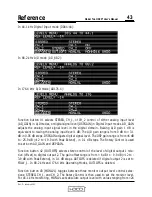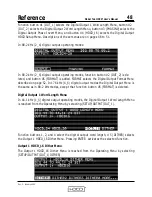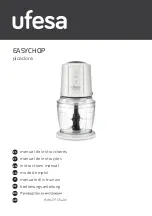
®
I N C .
P A C I F I C
M I C R O S O N I C S
33
Setup & Operation
Model Two HDCD
®
User’s Manual
Rev. C - January 2002
4X) signals. While DAC dither greatly improves the linearity of D/A conversion, it also adds
supersonic energy to the analog output signal, which will interact differently with various
types of line amplifiers and power amplifiers. Higher levels of dither generally improve DAC
linearity, but also can stress electronics that have limited high frequency slewing capabili-
ties. This can manifest as audible Transient Intermodulation Distortion, or a smearing of
detail. To allow the best possible match of dither to amplifier performance, three select-
able dither levels are provided for 1X conversion, and four levels are provided for 2X and 4X
conversion.
The best way to determine the optimum DAC dither for a specific monitoring system is by
listening to various types of source material while selecting different DAC dither curves.
Optimum settings should be determined separately for 1X and 2X/4X material. Generally,
the “wider-band” or “faster” the monitoring electronics, the higher the optimum dither
level will be. The factory preset dither level is P0 (preset 0) with M6 and M12 (minus 6 dB
and 12 dB) options available at 1X, and M3, M6 and P3 (minus 3 dB, minus 6 dB and plus
3 dB) options available at 2X/4X. DAC dither levels are set in the DAC-System Optimize
Menu (SETUP/MORE.../SYSTEM/DAC_OPT). Changing Presets does not change DAC dither
settings.
Compact Disc Release Mastering
The Model Two produces HDCD 16-bit, 44.1 kHz, Compact Disc release masters from both
analog sources or longer word length digital sources. If a digital source wasn’t made using
HDCD A/D conversion, its dynamic range can be preserved by using HDCD 16-bit amplitude
encoding and decoding, but without the benefit of HDCD A/D conversion and filtering.
HDCD Silence
When producing HDCD release masters, at least 200 milliseconds (1/5 second or 6 NTSC
video frames) of “HDCD Silence” must be provided before the beginning of each segment of
program audio. HDCD Silence is simply an HDCD signal with no program content. “Digital
(Video) Black” may be inserted prior to the 200 msec of HDCD Silence and immediately
following the end of HDCD program audio. The 200 msec of HDCD Silence allows HDCD
playback equipment time to perform any necessary switching or level adjustment.
Processing HDCD 16-bit Signals
No digital processing which alters the bit structure of an HDCD 16-bit signal can be per-
formed without losing the HDCD amplitude encoding information hidden in the signal’s
LSB. “Digital processing” includes any level change, EQ, dither, rounding, etc. Editing
which does not affect the bit structure of the 16-bit HDCD encoded signal, such as butt
splices or rapid cross fades, is OK. Cross fades should not be longer than 100 msec (3 video
frames). At least 30 msec (1 frame) should exist between the end of a splice or cross fade
and the beginning of a signal level transient. This period is required so that an HDCD
decoder has time to recognize the HDCD code.
















































